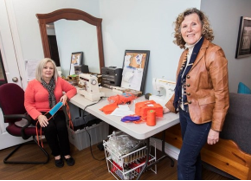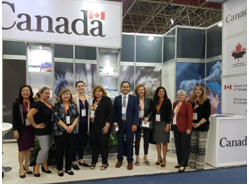
Lyse Moreau has continued the strong legacy and tradition of a woman-owned firm thriving in the Niagara region. International Sew Right (ISR) was founded by Lyse’s mother, Claudette Gauthier, in 1983. Following in her mother’s footsteps, Lyse began working at ISR in the 1980s, and became partners with her mother in 2001, making positive changes to get ISR ready to export. In 2006, she became the sole owner and, in 2011, ISR became a 100% woman-owned manufacturing facility.
Her 8,500 square-foot company facility is located in the industrial park near Chippawa in Niagara, with a dedicated team of eight employees, focused on importing and exporting uniquely improved safety garments and products. ISR’s core business over the years has been dedicated to custom-designing and manufacturing safety clothing, focusing on proximity suits, arc flash protection, high heat, fire-retardant and high-visibility clothing, coveralls, bib overalls, shop coats, aprons, sleeves, head protection, welders clothing and tarps, gloves, parkas, bomber jackets, and up to about 400 different types of safety products.
Under her leadership, Lyse has restructured operations in targeted ways that include upgrading the accounting and purchasing departments, automating cutting and sewing areas as well as redesigning the shipping and receiving departments.
Industry memberships such as those with OWIT-Toronto and the Niagara Industrial Association have been crucial to business growth. They have provided support networks, information and have supported wider market expansion, resource mobilization efforts and coordination in a sector that keeps booming.
“Business growth is always a top priority. ISR’s membership in OWIT-Toronto and the Niagara Industrial Association has been instrumental,” Lyse says. “Niagara Industrial Association members are all involved in some type of manufacturing, and they provide a good support system and information in the manufacturing field, which saves us a lot of time and is greatly appreciated.”

[left] Lyse Moreau graces the cover of the Niagara Industrial Association Magazine. [right] Lyse and team are featured in the Niagara Industrial Association Magazine.
Stepping into the gap, taking gigantic steps to product pivoting
Focusing on niche products and operating as a Tier 1 and Tier 2 company ready to assist anyone with a safety concern has meant more business wins for Lyse. This has been reflected in the number of accolades that Lyse and her company have received, including: the 2004 Niagara Entrepreneur of the Year Award; 2014 Ontario Health and Safety Golden Award (Reader’s Choice Award for Designing and Manufacturing Safety Apparel and Aluminized Clothing); 2015 Chamber of Commerce Entrepreneur of the year; 2015 Women’s Distinguish Award for Achievements in the Industry; and 2019 The Greater Niagara Chamber of Commerce Excellence in Manufacturing Award, among others.
Like every other business around the world, ISR was affected by the unique challenges caused by COVID-19. Despite challenges with delays to receive fabrics and textiles and key raw materials for ISR’s manufactured safety products, the company has also seen larger volume orders from companies requiring to stock up on inventory. Her company further rose to the challenge and championed the COVID-19 support program, which signalled ISR’s product pivot to making masks and a variety of other medical supplies including PET masks, face masks, hand sanitizers, gowns, lab coats and gloves. Lyse has since donated thousands of masks to frontline workers in the healthcare sector and to different communities in Ontario.
With the product pivot, ISR has since received orders to make masks from cotton, polycotton and fire-retardant fabrics for the healthcare industry. These masks are manufactured in different styles, colours, and are reaching families, nursing homes, hospitals, construction sites, foundries and other areas where they are desperately needed.
Leading by example, ISR was also quick to adopt the health and safety guidelines from medical experts, spacing all sewing machines at least six feet apart from one another, providing workers with protective items like gloves and masks, as well as following a strict cleaning schedule that included disinfecting surfaces that were regularly touched.
ISR’s domestic manufacturing base provided agility and speed to respond to the pandemic and rapidly shift to mask production. Lyse’s great oversight to restock materials before the pandemic also meant that their work was not stalled due to reliance on international vendors who couldn’t temporarily ship their products. A key lesson for Lyse and others in the manufacturing field has been an increased emphasis on self-sufficiency that will encourage domestic producers to expand their operations and resist offshoring.
“Keeping communities safe is integral to who we are at International Sew Right,” Lyse says. “We fully recognize that our company has an important role to play during this trying time of COVID-19, and we are ready to take on the gigantic steps to do all we can to help our communities to remain safe and to thrive.”


[left] ISR team at work. [right] Lyse launches the ‘COVER UP AGAINST COVID-19 CANADA’ support program, bringing together volunteers and the Niagara region community in an inclusive community engagement to sew masks to help with the shortage during the COVID-19 pandemic.
Expanding ISR’s international footprint
Lyse has been strategic in positioning ISR to ensure a competitive advantage in the global marketplace. ISR sells across Canada with a growing customer base in the US, and exports to Brazil and India, as well as plans to export to Mexico. To access the Mexico market, she participated in a trade mission organized by OWIT-Toronto in 2019 to the city of Monterrey in northeast Mexico. During this trade mission, top Canadian businesswomen were introduced to Mexican leads to leverage exporting opportunities, and this resulted in solid connections for ISR.
Lyse has also been fearless in taking her company to the next level, participating and presenting her company pitch to CBC’s auditions for TV’s Dragons’ Den in 2019 to expand business and increase the export base.
The COVID-19 pandemic has caused massive negative industry impacts in real time, disrupting supply chains and halting exports. However, the effects of the pandemic have also resulted in an unprecedented surge in demand for Personal Protective Equipment (PPE). This has led to companies like ISR that have pivoted to making masks and a variety of other medical supplies to expand their domestic production. The longer-term effects on the industry could be an increased emphasis on domestic production capacity to support national health concerns.
The safety and protective manufacturing industry in Ontario and worldwide thrives on the occupational health and safety regulations put in place to ensure that workplaces are safe and healthy. An increasing number of regulations have been introduced to protect workers from hazardous conditions that might cause injury. Increased changes in workforce operations and industrial growth will continue to sustain demand for industry products and mitigate industry volatility.
Lyse continues to aim higher to increase ISR’s market reach internationally to meet an increased worldwide demand from construction and industrial growth that will continue to drive forward the demand for safety and protective equipment into the next decade. Memberships in associations like OWIT-Toronto will be beneficial to stay the course, providing topical international trade information and trade missions to help expand market access for women.
“Seizing global opportunities is one of our priorities, and our membership with OWIT-Toronto is therefore key in this regard,” Lyse notes. “My experience at OWIT-Toronto’s trade mission in Monterrey was an eye-opener and I am keen to look at various strategies to leverage and tap into the different connections and networks from the mission.”


[left] Lyse at the Dragons' Den auditions. [right] Lyse participates in the OWIT-Toronto trade mission in Monterrey, Mexico with top Canadian women executives.
 OWIT-Toronto wants to provide you with current and valuable news and resources on a regular bases. We do this through our site as well as through our monthly newsletter. Sign up today to receive these in your inbox.
OWIT-Toronto wants to provide you with current and valuable news and resources on a regular bases. We do this through our site as well as through our monthly newsletter. Sign up today to receive these in your inbox. OWIT-Toronto wants to provide you with current and valuable news and resources on a regular bases. We do this through our site as well as through our monthly newsletter. Sign up today to receive these in your inbox.
OWIT-Toronto wants to provide you with current and valuable news and resources on a regular bases. We do this through our site as well as through our monthly newsletter. Sign up today to receive these in your inbox.